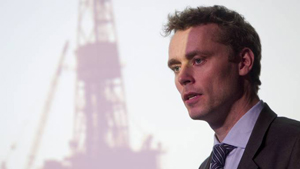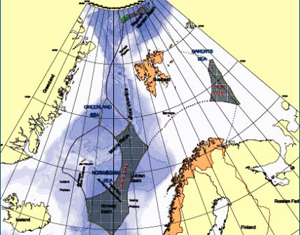Norway regains faith in its oil future
on
Norway regains faith in its oil future
Barely a year ago, many voices were heralding the end of the Golden Oil Age for Norway. The country seemed to have less than 10 years of oil production left. But recently the mood has changed. Several large discoveries were made that promise to extend Norway's oil and gas paradise far into the future. Not only that, but the new Minister of Petroleum and Energy, Ola Borten Moe, has effectively indicated that Norway will wholeheartedly join the rush for the riches of the Arctic, environmental concerns notwithstanding.
 |
| Minister of Petroleum and Energy Ola Borten Moe (photo: Bendiksby, Terje/Scanpix) |
The mood among the oil and gas producers on the Norwegian Continental Shelf (NCS) was fairly sombre. There was talk of the ‘sunset’ of Norway as an oil producing country. Since 1997 no big new discovery had been made. At the start of this year, the official figure for ‘undiscovered resources’ had been reduced by 4.473 billion barrels of oil-equivalents (boe) to 16.2 billion boe. Total remaining resources, including proved reserves, contingent resources and undiscovered resources stood at 46 billion boe, with just 6.7 billion barrels of proved reserves left. With an oil production of some 780 million barrels in 2010, this meant that Norway had less than 9 years of production to go. Indeed, Norway’s oil production had steadily declined over the past decade from a peak of 1.25 billion barrels in 2001.
Until things suddenly changed this year. Today, the Norwegian oil industry is full of optimism again. Two words explain this sudden change of mood: Aldous and Skrugard. One very surprising new oil find in the North Sea and a considerable new oil and gas discovery in the Barents Sea. Now that it has been established that the Aldous Major South field in the North Sea is connected with the neighbouring Avaldsnes field, discovered in the autumn of 2010, there is even talk of a new ‘elephant field’. And Skrugard provided evidence that the northern region was not as ‘dry’ as it seemed after many fruitless drillings there.
Flying start
And this is not all. There is yet another fact that has raised spirits in the Norwegian offshore industry: the new Minister of Petroleum and Energy. 35-year old Ola Borten Moe has made a flying start since he was installed in March of this year. In the summer he produced a White Paper (“An Industry for the Future: Norway’s Petroleum Activities”) which has led to great expectations. For one thing, it includes – for the first time since 1994 – an announcement that new areas will be opened up for oil and gas exploration.
‘The discoveries of first Skrugard then followed by the elephant field Aldous Major South/ Avaldsnes have completely changed the picture of a quite depressive industry and country’, says Thina M.Saltvedt, Senior Macro and Oil Analyst at Nordea Markets. The biggest surprise was Aldous Major South/Avaldsnes, since these two fields are located in the southern part of the North Sea, an area that was considered to be “mature”.
‘We did expect positive results, but not nearly as positive as this’, says BenteNyland, Director General of the Norwegian Petroleum Directorate. ‘Although the discovery has to be appraised, the area could contain so much oil overall that it enters the top 10 list of discoveries on the Norwegian Continental Shelf (NCS) and could prove the biggest find since the 1980s.’
For now the estimates for Aldous Major South are between 1.2 billion and 2.6 billion barrels of recoverable reserves, making it the third biggest field after Statfjord and Ekofisk. An advantage of Aldous is that water depth is just 115 metres in the area and a fully developed infrastructure for exploitation exists just 35 kilometres away. Oil has been produced in this region for 30 years. If all goes according to plan, the new find can be connected in 2018 already.
Champagne
Talking about Skrugard, Statoil CEO Helge Lund waxes even more enthusiastic. ‘The oil in this field is almost like Champagne’, he said. ‘Light and fine.’ This field is located in a different reservoir than the
| 'We did expect positive results, but not nearly as positive as this' |
According to Saltvedt, ‘the latest discoveries have changed the outlook for the future production on the NCS and last but not least it has increased optimism about new discoveries going forward.’
The new government’s White Paper has also been a pleasant surprise to the industry. It favours development of the Continental Shelf in a way that had not been expected from the Centre Party, to which the new Minister belongs, and which governs Norway in a coalition with the Social Democrats and the Socialist Left Party. The Centre Party, formerly the Agrarian Party, had always looked quite skeptically at the development of the oil industry.
But Ola Borten Moe seems to want to go in a new direction. He is making the following recommendations in his White Paper:
- to safeguard Norwegian interests in the cooperation area with Iceland
- to carry out knowledge acquisition regarding the effects of petroleum activity in the unopened parts in the north Norwegian provinces Troms and Nordland, after the agreement with Russia on maritime bounderies and cooperation in the Barents Sea, which gives Norway additional 80 000 square kilometers
- to initiate an impact assessment with a view to awarding production licenses and data acquisitionin the previously disputed area west of the delimitation line in the Barents Sea South
- to facilitate new petroleum activity in the region of Troms to the border with Russia by including these areas in future licensing rounds
- to consider the future need for new knowledge about resources in Skagerrak
The new Minister has also criticised environmental organisations for their ‘lack of realism’ when it comes to the development of the petroleum industry. This is a new sound from the Centre Party, which has traditionally been sympathetic to Greenpeace and critical about further developing the Continental Shelf. With this stance, however, the party lost a lot of support in the coastal regions. The local people in the area from Trondheim to the Russian border are dependent on agriculture and fishing and would like to join in “the new wealth” that is expected to come from the oil industry. Most of all they want jobs. If these do not materialize, the area will be faced with depopulation, which is not in the interest of the Centre Party. Nor in the interest of Ola Borten Moe himself. It is rumoured that the grandson of the former Chairman of the Centre Party and former Norwegian Prime Minister Per Borten would like to follow in his grandfather’s footsteps. To this end, he wants to bring the Centre Party back into the conservative, middle class camp to which it originally belonged. Liberation from the embrace of the socialist parties is said to be his goal.
Be prepared
‘The greatest potential for making new discoveries is in the sea areas outside Northern Norway’, the Minister has said. This is not a surprise, since in the North Sea over 1100 drillings have taken place, in the Norwegian Sea some 270 and in the Barents Sea only 90. With the expected climate warming,
| 'The oil in this field is almost like Champagne. Light and fine' |
Although the big potential for the future lies in the North, Norway does not want to ignore the South. The Norwegian Petroleum Directorate (NPD) devotes a lot of efforts to enhancing the recovery of the existing reserves along the entire coast. A classic example is the management of the Ekofisk field, Norway’s first production project. When it was discovered in 1969, and started producing in 1971, it was thought that some 17% of the resources were recoverable. The field should have been closed down long ago. Yet through technological progress, the recovery factor has been driven up to 50% and Ekofisk will be producing oil until 2050.
The NPD puts heavy pressure on the oil companies to improve their production processes. Key words are: long term thinking, patience, professional ability and creativity. One way of doing this is to attract new companies to the region. Until 2000 the list of operators and their partners was dominated by the two Norwegian companies Statoil and Norsk Hydro as well as the major international oil companies. Since that time over half of the licenses have been given to new entrants.
 |
| Illustration of the Norwegian Continental Shelf (source: regjeringen.no) |
The big oil companies tend to be interested only in very large new fields that bring high returns on investment. ‘There were business opportunities that many of the existing players on the NCS were not necessarily interested in pursuing,’ said the NPD. Medium-sized and smaller companies are prepared to make more drillings and to try and squeeze the last drop of oil out of a field, even if the rate of return is moderate.
Crazily expensive
However, for all companies cost is increasingly problematic in Norway.Costs for exploration per well in water depth less than 400 m are 85% higher in Norway than in the UK and 35% higher than in Brazil.
| There were business opportunities that many of the existing players on the NCS were not necessarily interested in pursuing |
According to Senior Advisor Frian Årsnes from consultancy Econ Pöyry, some companies are deliberately limiting their drilling activities because of the high costs. In 2010 some 160 drillings were made on the NCS. ‘To maintain the level of production as reported to the NPD, the number of wells drilled annually must be increased to 250 by 2015.’ The NPD maintains that activities on the NCS are profitable. ‘Exploration activities yielded substantial value both for the companies and for the Norwegian community’, it said in a recent resource report.
Current and planned activities seem to confirm the continuing attractiveness of the Norwegian Continental Shelf. This year €25.5 billion will be invested and for 2011-2014 investments should run to about €89 billion, according to consultancy RystadEnergi – making Norway the most capital-intensive offshore oil exploration region in the world.
|
The 10 Oil Commandments of Norwegian oil policy The 10 Oil Commandments are Chapters in adeclaration of principles underpinning Norwegian oil policy, submitted by the Standing Committeeon Industry in a Storting White Paperdated 14 June 1971. These principles have subsequentlybeen dubbed the 10 Oil Commandments, and represented a clarification of what was needed to make sure that the oil activities would "benefit the entire nation": 1. That national supervision and control of allactivity on the Norwegian Continental Shelfmust be ensured. |


Discussion (0 comments)